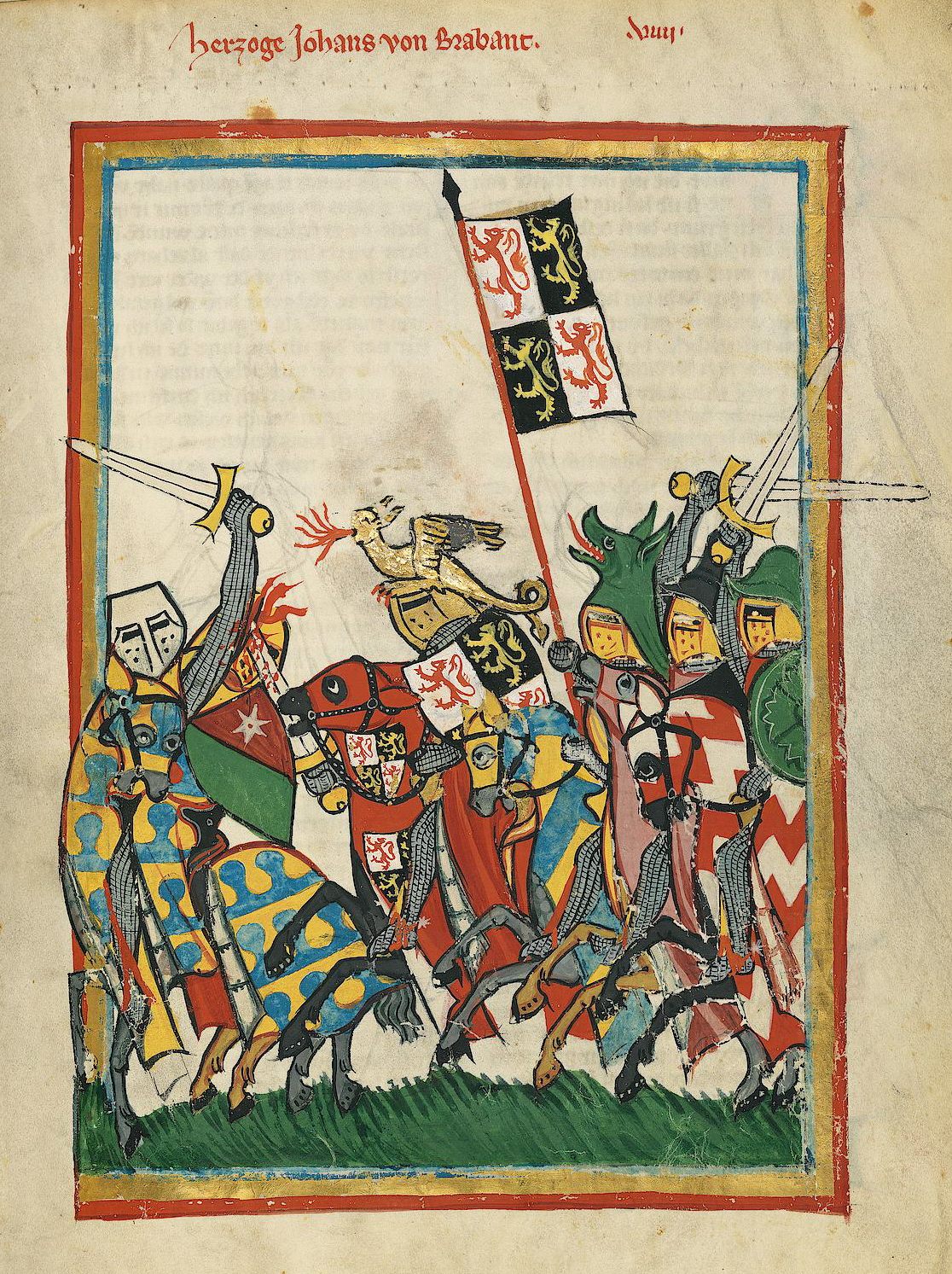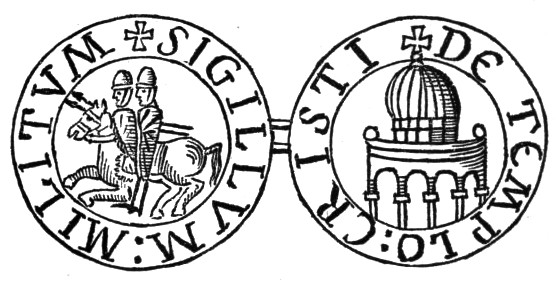|
Baucent
''Baucent'' (''bauceant, baussant'', etc.) was the name of the war flag (''vexillum belli'') used by the Knights Templar in the 12th and 13th centuries. 13th-century sources show it as a white gonfanon with a black chief (''argent a chief sable''). Jacques de Vitry, writing in the 1220s, mentions the ''gonfanon baucent'' and explains that the black and white colours symbolise the Templar's ferocity towards their enemies and their kindness towards their friends. It appears that later in the 13th century, the red cross of the Templar could be added to the banner. In a damaged fresco of the late 13th century in the Templar church of San Bevignate, Perugia, a Templar banner is depicted with the upper half in white and the lower half in black, with the red cross patty attached to the white field. The same fresco also shows a shield and horse-covers in the same design. The name ''baucent'' (also spelled ''bausent, bauceant, baussant, beausseant, beauséant'' etc.D. H. Wolf, ' ... [...More Info...] [...Related Items...] OR: [Wikipedia] [Google] [Baidu] |
Old French
Old French (, , ; Modern French: ) was the language spoken in most of the northern half of France from approximately the 8th to the 14th centuries. Rather than a unified language, Old French was a linkage of Romance dialects, mutually intelligible yet diverse, spoken in the northern half of France. These dialects came to be collectively known as the , contrasting with the in the south of France. The mid-14th century witnessed the emergence of Middle French, the language of the French Renaissance in the Île de France region; this dialect was a predecessor to Modern French. Other dialects of Old French evolved themselves into modern forms (Poitevin-Saintongeais, Gallo, Norman, Picard, Walloon, etc.), each with its own linguistic features and history. The region where Old French was spoken natively roughly extended to the northern half of the Kingdom of France and its vassals (including parts of the Angevin Empire, which during the 12th century remained under Anglo-Norman rul ... [...More Info...] [...Related Items...] OR: [Wikipedia] [Google] [Baidu] |
Military Flags
A war flag, also known as a military flag, battle flag, or standard, is a variant of a national flag for use by a country's military forces when on land. The nautical equivalent is a naval ensign. Under the strictest sense of the term, few countries today currently have proper war flags, most preferring to use instead their state flag or standard national flag for this purpose. __TOC__ History Field signs were used in early warfare at least since the Bronze Age. The word ''standard'' itself is from an Old Frankish term for a field sign (not necessarily a flag). The use of flags as field signs apparently emerges in Asia, during the Iron Age, possibly in either China or India.flag. (2008). Encyclopædia Britannica. Chicago: Encyclopædia Britannica. in Achaemenid Persia, each army division had its own standard, and "all officers had banners over their tents".E. Pottier, ''Douris'', London, 1909, p. 105 fig. 20, Plate XXV.b Early field signs that include, but are not limited t ... [...More Info...] [...Related Items...] OR: [Wikipedia] [Google] [Baidu] |
Knights Templar Seal
The Grand Masters of the Knights Templar during the later 12th and the 13th century used a double-sided seal which showed a representation of The Dome of the Rock (or a circular dome of the Church of the Holy Sepulchre) on one side, and the Order's symbol of two knights on one horse on the other side. This design is first attested as in use by Bertrand de Blanquefort, the order's sixth Grand Master, in 1158, forty years after its foundation, and it remained in use until the dissolution of the order in 1312. There was also a smaller, single-sided seal, which showed the Dome of the Rock (or the Holy Sepulchre), only. Different seals were used by provincial masters of the order. According to a papal bull issued by Innocent IV in 1251, it was customary for successive provincial masters to use the same seal. The master of Provence continued to use an Agnus Dei seal, while the seal of the Aragonese master William of Cardona and his successors depicted a knight on horseback, carryin ... [...More Info...] [...Related Items...] OR: [Wikipedia] [Google] [Baidu] |
Alexander The Great
Alexander III of Macedon ( grc, wikt:Ἀλέξανδρος, Ἀλέξανδρος, Alexandros; 20/21 July 356 BC – 10/11 June 323 BC), commonly known as Alexander the Great, was a king of the Ancient Greece, ancient Greek kingdom of Macedonia (ancient kingdom), Macedon. He succeeded his father Philip II of Macedon, Philip II to the throne in 336 BC at the age of 20, and spent most of his ruling years conducting a lengthy military campaign throughout Western Asia and ancient Egypt, Egypt. By the age of thirty, he had created one of the List of largest empires, largest empires in history, stretching from Greece to northwestern Historical India, India. He was undefeated in battle and is widely considered to be one of history's greatest and most successful military commanders. Until the age of 16, Alexander was tutored by Aristotle. In 335 BC, shortly after his assumption of kingship over Macedon, he Alexander's Balkan campaign, campaigned in the Balkans and reasserted control ... [...More Info...] [...Related Items...] OR: [Wikipedia] [Google] [Baidu] |
Albert Mackey
Albert may refer to: Companies * Albert (supermarket), a supermarket chain in the Czech Republic * Albert Heijn, a supermarket chain in the Netherlands * Albert Market, a street market in The Gambia * Albert Productions, a record label * Albert Computers, Inc., a computer manufacturer in the 1980s Entertainment * ''Albert'' (1985 film), a Czechoslovak film directed by František Vláčil * ''Albert'' (2015 film), a film by Karsten Kiilerich * ''Albert'' (2016 film), an American TV movie * ''Albert'' (Ed Hall album), 1988 * "Albert" (short story), by Leo Tolstoy * Albert (comics), a character in Marvel Comics * Albert (''Discworld''), a character in Terry Pratchett's ''Discworld'' series * Albert, a character in Dario Argento's 1977 film ''Suspiria'' Military * Battle of Albert (1914), a WWI battle at Albert, Somme, France * Battle of Albert (1916), a WWI battle at Albert, Somme, France * Battle of Albert (1918), a WWI battle at Albert, Somme, France People * Albert (given ... [...More Info...] [...Related Items...] OR: [Wikipedia] [Google] [Baidu] |
Freemasons
Freemasonry or Masonry refers to fraternal organisations that trace their origins to the local guilds of stonemasons that, from the end of the 13th century, regulated the qualifications of stonemasons and their interaction with authorities and clients. Modern Freemasonry broadly consists of two main recognition groups: * Regular Freemasonry insists that a volume of scripture be open in a working lodge, that every member profess belief in a Supreme Being, that no women be admitted, and that the discussion of religion and politics be banned. * Continental Freemasonry consists of the jurisdictions that have removed some, or all, of these restrictions. The basic, local organisational unit of Freemasonry is the Lodge. These private Lodges are usually supervised at the regional level (usually coterminous with a state, province, or national border) by a Grand Lodge or Grand Orient. There is no international, worldwide Grand Lodge that supervises all of Freemasonry; each Grand Lod ... [...More Info...] [...Related Items...] OR: [Wikipedia] [Google] [Baidu] |
Battle Cry
A battle cry or war cry is a yell or chant taken up in battle, usually by members of the same combatant group. Battle cries are not necessarily articulate (e.g. "Eulaliaaaa!", "Alala"..), although they often aim to invoke patriotic or religious sentiment. Their purpose is a combination of arousing aggression and esprit de corps on one's own side and causing intimidation on the hostile side. Battle cries are a universal form of display behaviour (i.e., threat display) aiming at competitive advantage, ideally by overstating one's own aggressive potential to a point where the enemy prefers to avoid confrontation altogether and opts to flee. In order to overstate one's potential for aggression, battle cries need to be as loud as possible, and have historically often been amplified by acoustic devices such as horns, drums, conches, carnyxes, bagpipes, bugles, etc. (see also martial music). Battle cries are closely related to other behavioral patterns of human aggression, such as wa ... [...More Info...] [...Related Items...] OR: [Wikipedia] [Google] [Baidu] |
Baldric
A baldric (also baldrick, bawdrick, bauldrick as well as other rare or obsolete variations) is a belt worn over one shoulder that is typically used to carry a weapon (usually a sword) or other implement such as a bugle or drum. The word may also refer to any belt in general, but this usage is poetic or archaic. In modern contexts, military drum majors usually wear a baldric. Usage Baldrics have been used since ancient times, usually as part of military dress. The design offers more support for weight than a standard waist belt, without restricting movement of the arms, and while allowing easy access to the object carried. Alternatively, and especially in modern times, the baldric may fill a ceremonial role rather than a practical one. Most Roman tombstones in the third century had depictions of white baldrics. Design One end of the baldric was broad and finished in a straight edge, while the other was tapered to a narrow strip. The narrow end was brought through a scabb ... [...More Info...] [...Related Items...] OR: [Wikipedia] [Google] [Baidu] |
Piebald
A piebald or pied animal is one that has a pattern of unpigmented spots (white) on a pigmented background of hair, feathers or scales. Thus a piebald black and white dog is a black dog with white spots. The animal's skin under the white background is not pigmented. Location of the unpigmented spots is dependent on the migration of melanoblasts (primordial pigment cells) from the neural crest to paired bilateral locations in the skin of the early embryo. The resulting pattern appears symmetrical only if melanoblasts migrate to both locations of a pair and proliferate to the same degree in both locations. The appearance of symmetry can be obliterated if the proliferation of the melanocytes (pigment cells) within the developing spots is so great that the sizes of the spots increase to the point that some of the spots merge, leaving only small areas of the white background among the spots and at the tips of the extremities. Animals with this pattern may include birds, cats, cattl ... [...More Info...] [...Related Items...] OR: [Wikipedia] [Google] [Baidu] |
Caparison
A caparison is a cloth covering laid over a horse or other animal for protection and decoration. In modern times, they are used mainly in parades and for historical reenactments. A similar term is horse-trapper. The word is derived from the Latin ''caparo'', meaning a cape. Horses In antiquity, a "magnificently caparisoned horse" takes a central place in a Vision (spirituality), vision reported in the deutero-canonical text, , which prevents the Seleucid emissary Heliodorus (minister), Heliodorus from a planned assault on the Jewish temple treasury in Jerusalem. In the Middle Ages, caparisons were part of the horse armour known as barding, which was worn during Medieval warfare, battle and Tournament (medieval), tournaments. They were adopted in the twelfth century in response to conditions of campaigning in the Crusades, where local armies employed archers, both on foot and horse, in large quantities. The covering might not completely protect the horse against the arrows but i ... [...More Info...] [...Related Items...] OR: [Wikipedia] [Google] [Baidu] |




